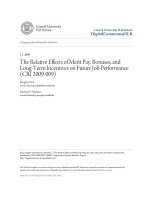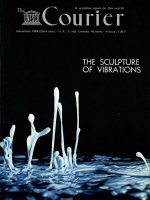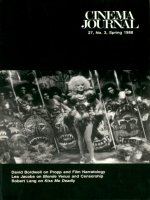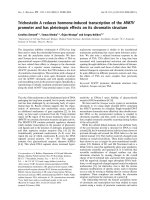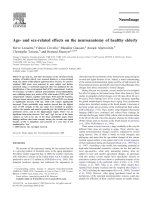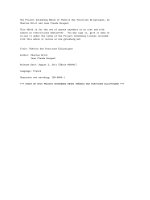Sculpture of the Exposition Palaces and Courts Descriptive Notes on the Art of the Statuary at the Panama-Pacific International Exposition San Francisco ppt
Bạn đang xem bản rút gọn của tài liệu. Xem và tải ngay bản đầy đủ của tài liệu tại đây (233.16 KB, 67 trang )
Sculpture of the Exposition
Palaces and Courts
Descriptive Notes on the
Art of the Statuary at the
Panama-Pacific International Exposition
San Francisco
By Juliet James
To A. Stirling Calder who has so ably managed the execution of the
sculpture, and to the vast body of sculptors and their workmen who have
given the world such inspiration with their splendid work, this book is
dedicated.
Foreword
What accents itself in the mind of the layman who makes even a cursory
study of the sculptors and their works at the Panama-Pacific
International Exposition is the fine, inspiring sincerity and uplift
that each man brings to his work. One cannot be a great sculptor
otherwise.
The sculptor's work calls for steadfastness of purpose through long
years of study, acute observation, the highest standards, fine
intellectual ability and above all a decided universalism - otherwise
the world soon passes him by.
It is astonishing to see brought together the work of so many really
great sculptors. America has a very large number of talented men
expressing themselves on the plastic side - and a few geniuses.
The Exposition of 1915 has given the world the opportunity of seeing the
purposeful heights to which these men have climbed.
We have today real American sculpture - work that savors of American
soil - a splendid national expression.
Never before have so many remarkable works been brought together; and
American sculpture is only in its infancy - born, one might say, after
the Centennial Exposition of 1876.
The wholesome part of it all is that men and women are working
independently in their expressions. We do not see that effect here of
one man trying to fit himself to another man's clothing. The work is all
distinctly individual. This individualism for any art is a hopeful
outlook.
The sculpture has vitalized the whole marvelous Exposition. It is not an
accessory, as has been the sculpture of previous Expositions, but it
goes hand in hand with the architecture, poignantly existing for its own
sake and adding greatly to the decorative architectural effects. In many
cases the architecture is only the background or often only a pedestal
for the figure or group, pregnant with spirit and meaning.
Those who have the city's growth at heart should see to it that these
men of brain and skill and inspiration are employed to help beautify the
commercial centers, the parks, the boulevards of our cities.
We need the fine lessons of beauty and uplift around us.
We beautify our houses and spend very little time in them. Why not
beautify our outside world where we spend the bulk of our time?
We, a pleasure-loving people, are devoting more time every year to
outside life. Would it not be a thorough joy to the most prosaic of us
to have our cities beautified with inspiring sculpture?
We do a great deal in the line of horticultural beautifying - we could
do far more - but how little we have done with one of the most
meaningful and stimulating of the arts.
Let us see to it, in San Francisco at least, that a few of these works
are made permanent.
Take as an example James Earle Fraser's "End of the Trail." Imagine the
effect of that fine work silhouetted against the sky out near Fort
Point, on a western headland, with the animal's head toward the sea, so
that it would be evident to the onlooker that the Indian had reached the
very end of the trail. It would play a wonderful part in the beauty of
the landscape.
Or take Edith Woodman Burroughs' "Youth." What a delight a permanent
reproduction of that fountain would be if placed against the side of one
of the green hills out at Golden Gate Park - say near the Children's
Playground - with a pool at its base. It is only by concerted action
that we will ever get these works among us. Who is going to take the
lead?
The Contents
Introduction
The Fountain of Energy
The Mother of Tomorrow
The Nations of the Occident
The Nations of the Orient
The Alaskan
The Lama
The Genius of Creation
The Rising Sun
Descending Night
Winter
The Portals of El Dorado
Panel of the Fountain of El Dorado
Youth
The American Pioneer
Cortez
The End of the Trail
Panel from the Column of Progress
The Feast of the Sacrifice
The Joy of Living
The Man with the Pick
The Kneeling Figure
The Pegasus Panel
Primitive Man
Thought
Victory
The Priestess of Culture
The Adventurous Bowman
Pan
Air
The Signs of the Zodiac
The Fountain of Ceres
The Survival of the Fittest
Earth
Wildflower
Biographies of Sculptors
Sculpture Around the Fine Arts Lagoon
The Illustrations
The Fountain of Energy - A. Stirling Calder, Sculptor
The Mother of Tomorrow - A. Stirling Calder, Sculptor
The Nations of the Occident - A. Stirling Calder, Frederick Roth, Leo
Lentelli, Sculptors
The Nations of the Orient - A. Stirling Calder, Frederick Roth, Leo
Lentelli, Sculptors
The Alaskan - Frederick Roth, Sculptor
The Lama - Frederick Roth, Sculptor
The Genius of Creation - Daniel Chester French, Sculptor
The Rising Sun - Adolph Alexander Weinman, Sculptor
Descending Night - Adolph Alexander Weinman, Sculptor
Winter - Furio Piccirilli, Sculptor
The Portals of El Dorado - Gertrude Vanderbilt Whitney, Sculptor
Panel of the Fountain of El Dorado - Gertrude Vanderbilt Whitney,
Sculptor
Youth - Edith Woodman Burroughs, Sculptor
The American Pioneer - Solon Hamilton Borglum, Sculptor
Cortez - Charles Niehaus, Sculptor
The End of the Trail - James Earle Fraser, Sculptor
Panel from the Column of Progress - Isidore Konti, Sculptor
The Feast of the Sacrifice - Albert Jaeger, Sculptor
The Joy of Living - Paul Manship, Sculptor
The Man with the Pick - Ralph Stackpole, Sculptor
The Kneeling Figure - Ralph Stackpole, Sculptor
The Pegasus Panel - Bruno Louis Zimm, Sculptor
Primitive Man - Albert Weinert, Sculptor
Thought - Albert Weinert, Sculptor
Victory - Louis Ulrich, Sculptor
The Priestess of Culture - Herbert Adams, Sculptor
The Adventurous Bowman - Herman A. MacNeil, Sculptor
Pan - Sherry Fry, Sculptor
Air - Robert Ingersoll Aitken, Sculptor
The Signs of the Zodiac - Herman A. MacNeil, Sculptor
The Fountain of Ceres - Evelyn Beatrice Longman, Sculptor
The Survival of the Fittest - Robert Ingersoll Aitken, Sculptor
Earth - Robert Ingersoll Aitken, Sculptor
Wildflower - Edward Berge, Sculptor
Sculpture of the Exposition Palaces and Courts
"The influence of sculpture is far reaching. The mind that loves this
art and understands its language will more and more insist on a certain
order and decorum in visual life. It opens an avenue for the expression
of aesthetic enjoyment somewhere between poetry and music and akin to
drama. - Arthur Hoeber
The Fountain of Energy
A. Stirling Calder, Sculptor [See Frontispiece]
The Fountain of Energy is a monumental aquatic composition expressing in
exuberant allegory the triumph of Energy, the Lord of the Isthmian Way.
It is the central sculptural feature of the South Garden, occupying the
great quatrefoil pool in front of the tower. The theme is Energy, the
Conqueror - the Over Lord - the Master; Energy, mental and physical;
Energy - the Will, the indomitable power that achieved the Waterway
between the Oceans at Panama. The Earth Sphere, supported by an
undulating frieze of mer-men and women, is his pedestal. Advancing from
it in the water at the four relatively respective points of the compass,
North, South, East and West, are groups representing the Atlantic and
the Pacific Oceans and the North and the South Seas; groups richly
imaginative, expressing types of Oriental, Occidental, Southern and
Northern land and sea life. The interrupted outer circle of water motifs
represent Nereids driving spouting fish. Vertical zones of writhing
figures ascend the sphere at the base of the Victor. Across the upper
portions of the sphere, and modeled as parts of the Earth, stretch
titanic zoomorphs, representing the Hemispheres, East and West. The
spirit of the Eastern Hemisphere is conceived as feline and
characterized as a human tiger cat. The spirit of the Western Hemisphere
is conceived as taurine and characterized as a human bull. The base of
the Equestrian is surrounded by a frieze of architecturalized fish and
the rearing sea horses that furnish the principal upper motif for the
play of water. Energy himself is presented as a nude male, typically
American, standing in his stirrups astride a snorting charger - an
exultant super-horse needing no rein - commanding with grandly elemental
gesture of extended arms, the passage of the Canal. Growing from his
shoulders, winged figures of Fame and Valor with trumpet, sword and
laurel, forming a crest above his controlling head, acclaim his triumph.
The Fountain embodies the mood of joyous, exultant power and exactly
expresses the spirit of the Exposition. Its unique decorative character
has been aptly described as heraldic, "The Power of America rising from
the Sea."
A. Stirling Calder
The Mother of Tomorrow
A. Stirling Calder, Sculptor
With upturned face, with steady onward gaze, the stalwart Mother of
Tomorrow moves ahead. Hers is the firm, determined purpose, the will to
do - to accomplish that for which she has started. She marches ahead of
the types of the Occident. It has taken all these types striving with
common purpose to produce the future, therefore they form the Mother of
Tomorrow, the matrix from which the future generations are to come. Mr.
Calder's high, splendid ideals are directly mirrored in this one figure.
It is not hard to read the man in his handiwork.
The Nations of the Occident
A. Stirling Calder, Frederick Roth, Leo Lentelli, Sculptors
Into the great Court of the Universe, from the top of the Arch of the
Occident, march the types of men who have made the Western civilization.
From left to right - the French-Canadian, the Alaskan, the German, the
Latin-American, the Italian, the Anglo-American, the Squaw, the American
Indian. In the center of this well-balanced pyramidal group, surmounted
by Enterprise and drawn by sturdy oxen, comes the old prairie schooner.
To right and left atop are seen the Heroes of Tomorrow - one a white
boy, the other a negro type. In front marches the splendid Mother of
Tomorrow.
The Nations of the Orient
A. Stirling Calder, Frederick Roth, Leo Lentelli, Sculptors
Atop the Arch of the Orient is the superb tableau representing the types
of men that form the Orientals. From left to right - the Arab Sheik, the
Negro Servitor, the Egyptian Warrior, the Arab Falconer, the Indian
Prince and Spirit of the East, the Lama, the Mohammedan Warrior, the
Negro Servitor, the Mongolian Warrior. On they come to join the Nations
of the West in the great Court of the Universe. This group is as fine as
any group ever seen at an exposition. It rises in its impressive
pyramidal height to a climax in the Spirit of the East - a fitting pivot
on which to turn the types.
The Alaskan
Frederick Roth, Sculptor
Frederick Roth has fashioned one of the most expressive figures of the
Exposition sculpture, but so far above the eye is she and so
overshadowed by her companions, that we do not see her in her true
light. It is the Alaskan Indian of the Nations of the Occident. She is
moving on with her totem poles and blankets. You feel her tug and
strain, for her load is growing heavier with each step, and she has yet
a long way to go. The modeling of the figure, the foot, the rigid arm
and hand, all tell of sustained effort that is truly life-like in
expression.
The Lama
Frederick Roth, Sculptor
The priest of Thibet, the Lama, passes on his onward march before you.
You do not wonder what race claims him. He is of Mongolian blood. He
stolidly passes by, looking neither to the right nor to the left. He is
used to being obeyed. His rod of authority tells you that what he says
is law. Indifference and arrogance are on his face. His very posture,
the very way in which his robe hangs from his shoulders, the position of
his nerveless fingers that hold the rod, speak of centuries of
indifference to everything except what he thinks.
The Genius of Creation
Daniel Chester French, Sculptor
The Spirit of Creation is a bisexual being, and yet you feel the spirit
and not the flesh. Its idealism is of the highest order, being largely
produced by the hood drawn far over the face, throwing such deep shadow
that personality is lost sight of and only creative force is left. High
on a mighty boulder it sits with arms raised. The word has just been
spoken and man and woman have come forth - their feet on the serpent,
the symbol of wisdom and eternity. At the rear of the group their hands
meet as if in mutual dependence, while above appear the Alpha and Omega
- "I am the beginning and the end."
The Rising Sun
Adolph Alexander Weinman, Sculptor
This fresh, strong young Sun is about to start on his journey - dawn is
soon to break upon the world. With muscles stretched, the wind blowing
through his hair, the heavenly joy of the first move expressed upon his
face, the vigor of young life pulsating through his body, he will start
the chest forward and move those outstretched wings. Let us preserve
this glorious figure for our western city. It would so admirably suggest
the new light that has been shed upon San Francisco by the Exposition of
nineteen hundred and fifteen, as well as the new light occasioned by the
opening of the Panama Canal.
Descending Night
Adolph Alexander Weinman, Sculptor
The figure on the page opposite is a beautiful lyric poem. She might be
called "A Hymn to the Night." Every line of her figure is musical, every
move suggested, rhythmical. Seen at night, she croons you a slumber
song. How subtly Mr. Weinman has told you that she comes to fold the
world within her wings - to create thru her desire a "still and
pulseless world." The muscles are all lax - the head is drooping, the
arms are closing in around the face, the wings are folding, the knees
are bending - and she too will soon sink to slumber with the world in
her arms. What a fine contrast of feeling between the tense young "Sun"
and relaxed "Descending Night."
Winter
Furio Piccirilli, Sculptor
Naked Winter stands before you. It is the period of the year when the
leaves are of the trees and the bark is splitting. After the activities
of autumn man is resting. The fruits have been gathered - the golden
apples and the purple grapes - so man's labors have ceased. It is the
period of conception. The sower has just cast forth the seed. Mother
Earth will nurture the little seed until the cold winter has passed and
the warm sunshine comes again to give each clod its "stir of might."
The Portals of El Dorado
Gertrude Vanderbilt Whitney, Sculptor
There was once among the South American tribes a belief that in a
certain far-off country lived a king called El Dorado, the Gilded One.
He ruled over a region where gold and precious stones were found in
abundance. The story influenced a vast number of adventurers who led
expeditions to seek the land of golden treasure; but notwithstanding the
fact that their searched most carefully and for long periods, they all
failed to find it. The idea of the unattainable gave the suggestion to
Mrs. Whitney for her fountain. The gold of El Dorado was used as a
symbol of all material advantages which we so strongly desire - wealth,
power, fame, et cetera.
Panel of the Fountain of El Dorado
Gertrude Vanderbilt Whitney, Sculptor
In the panel are seen men and women in their mad race for the
unattainable. Many have had a glimpse of the Gilded One, and are rushing
on to pass the mysterious gate behind which the desires of life await
them. Some faint by the roadside or stop in their race for the goal to
contend or to loiter by the way, but those nearest the El Dorado
increase their speed. Beside the gateway that has only just allowed the
Gilded One to pass thru are two mortals who have come close to the land
of their desires, but only to find the door shut and slaves beside it
barring the way. Their strength is expended, their courage gone in the
long race for material things.
Youth
Edith Woodman Burroughs, Sculptor
A little figure of innocence and purity in all her virgin loveliness
stands before you - the incarnation of all that is fresh and wholesome.
She is only a slip of a girl and yet the dignity of her carriage
betokens hopeful days for her womanhood later on. Her form is
exquisitely moulded. Those little bony shoulders will all too soon fill
out and she will bloom into womanhood. The chief charm of this little
lady is her simplicity. Mrs. Burroughs uses such beauty of line, such
sweet language to tell her story.
The American Pioneer
Solon Hamilton Borglum, Sculptor
Erect, dignified, reflecting on the things that have been, the American
Pioneer appears before us, reminding us that to him should be given the
glory for the great achievements that have been made on the American
Continent. He it was who blazed the trail that others might follow. He
endured the hardships, carved the way across the continent, and made it
possible for us of today to advance thru his lead. All hail to the
white-headed, noble old pioneer who, with gun and axe, pushed his way
thru the wilderness; whose gaze was always upward and onward, and whose
courage was unfaltering!
Cortez
Charles Niehaus Sculptor
One of the finest equestrians at the Exposition is Cortez by Charles
Niehaus. As we look upon the rider on his sumptuously caparisoned horse
we are convinced that he is every inch a conqueror. He is represented
absolutely motionless - his feet in the stirrups - and yet you feel that
he is a man of tremendous action. You also feel his fine reserve, and
yet how spirited he is! This is that intrepid spirit that desired the
land of the Montezumas. After determined invasions he conquered the
country in the early part of the sixteenth century.
The End of the Trail
By James Earle Fraser, Sculptor
"The trail is lost, the path is hid, and winds that blow from out the
ages sweep me on to that chill borderland where Time's spent sands
engulf lost peoples and lost trails."
- Marion Manville Pope.
One of the strongest works of the Exposition in its intense pathos is
this conception of the end of the Indian race. Over the country the
Indian has ridden for many a weary day, following the long trail that
leads across a continent. A blizzard is on. He has peered to right and
left, but alas! the trail is gone and only despair is his. So has it
been with the Indian. His trail is now lost and on the edge of the
continent he finds himself almost annihilated.
Panel from the Column of Progress
By Isidore Konti, Sculptor
The four panels on the Column of Progress show the different mental
conditions of men on their onward march thru life. In the center of the
panel stands the man of inspiration - the eagle, bird of inspiration,
perched on his shoulder. He goes thru life with upturned face, depending
upon his God for strength. Beside him on the right is seen the warrior
who wins his way by sheer physical strength. On his left stands the
ascetic philosopher, who through constant vigils "hath a lean and hungry
look." To the extreme left falteringly steps the man who fears the
unknown future; his wife and mother sustain him by spiritual cheer. The
figures are in very high relief so that they seem almost human as you
gaze upon them.
The Feast of the Sacrifice
Albert Jaegers, Sculptor
In your imagination you see as of old the harvest procession marching
around the fields. It is led by the great bulls for the sacrifice to the
gods, that the harvest may yield bounteously. On either side of the
bulls are the youths and the maids carrying flowered festoons. The long
procession passes on and halts before the altar where the bull being
sacrificed, the head with its festoons is placed upon the side of the
altar. A most decorative group is this Feast of the Sacrifice - brute
strength and the graceful form of the maid making a splendid play of
line that most satisfactorily charms the eye.
The Joy of Living
Paul Manship, Sculptor
With perfect abandon come these maidens into the Court of the Universe,
carrying their festoons of wild roses. They bring to the great festival
joy and love of life - a telling addition to all that has been expressed
in the court. They savor of old Greek days, these maidens of archaic
hair and zigzag draperies. Paul Manship loves the classic which brings
with it much of free expression, and he has adopted the archaic style
that recalls the figures such as are seen on old Greek vases. No one is
more joyous among the sculptors than this man. He has a rarely beautiful
gift from the gods.
The Man With the Pick
Ralph Stackpole, Sculptor
An ordinary workman with his pick - and yet how impressed you are with
his sincerity. In him is asserted the dignity, the usefulness, the
nobility of all labor. He helps to turn the wheels of trade, to further
the interests of the world. He works patiently day by day,
notwithstanding the fact that those above him reap the benefits. Mr.
Stackpole has been most happy in his expression. The broad treatment is
thoroughly suitable to just such work as this. There are no accessories
employed. The work is absolutely direct.
The Kneeling Figure
Ralph Stackpole, Sculptor
With the love for all that is beautiful in life, in what God has made
and in what man has fashioned, the grateful devotee has mounted the
steps that lead to the altar at which she offers up her devotion. She
bows her head in humble reverence to her God for all that He has given
her to enjoy - all that is good, pure, true, beautiful, uplifting. And
we onlookers, too, would join the moving throng that bend the knees at
the altar of beauty and truth. Across the lagoon we gaze upon the great
stillness, and we with her murmur, "Father, I thank Thee."
The Pegasus Panel
Bruno Louis Zimm
There are no reliefs more classically inspiring than are these superb
reliefs by Bruno Zimm. The one on the opposite page is of great beauty.
The young artist has caught the inspiration of his art - he has bridled
Pegasus. Beside him march the Arts - Literature, holding aloft her
symbol, the lamp; Sculpture extending in front of her the statuette, a
devotee admiring, and Music leading the procession, stilling ever the
beasts - a veritable Orpheus. Mr. Zimm has been most successful in the
fine working out of his subject in a classical way, for the style of
relief work accords well in feeling with the superb classic architecture
it decorates.
Primitive Man
Albert Weinert, Sculptor
Long ages past I lived and gave no thought of time or doing aught save
going as my fancy took me. Ofttimes I took my bow and arrow and hide me
to the mighty forests where herds of Nature's roaming kind served as my
food when I required it. Again I followed to the sea where, casting in
my net, I drew up myriads of the finny tribe to satisfy my appetite. Oft
drew I up such numbers vast that having naught to do but to amuse myself
I fed my extra fish the friendly pelican that had become companion in my
walks along the shore. A simple man was I with not too many thoughts and
only few desires. My body was my foremost daily thought, and little
cared I for aught else besides.
Thought
Albert Weinert, Sculptor
The ages have passed on and I more thoughtful have become, for mighty
revolutions have gone on within my frame. My mind, a once too puny
thing, has year by year grown stronger, until to-day I realize that
feeble is my flesh - a thing to be abhorred, and mind does rule above
all else. My very face which once was rude and lacked that fire that
strong intelligence does give now has a steady purpose and fine spirit
writ upon it. It is as if my flesh of old had dropped and like a
cast-off cloak had fallen at my feet. Then come those days when tumult
as of yore is waged within me, and then I grasp my new-made self and
yearn to hold my old position within the body walls. Thought more strong
than flesh does wield its strength and back I crouch beneath the feet to
stay till Thought is off his guard again.
Victory
Louis Ulrich, Sculptor
Against the blue sky, with wings poised and draperies blown back,
appears a Victory from every gable point of the palaces of the
Exposition. She is positively charming in her sweep forward. Poised far
above you, she holds the laurel wreath ready for the victor. Blessed
Victories! We rejoice that there are so many of you for we have found so
many victors. Sideview, against the clear blue sky, she suggests the
great victory of Samothrace. Mr. Ulrich, we feel sure that the Lady
Samothrace has exerted her subtle influence.
The Priestess of Culture
Herbert Adams, Sculptor
There are few sculptors with greater refinement or more cultured reserve
than Herbert Adams. He understands the selection of the significant and
in many ways seems most fitting to represent the Priestess of Culture.
This figure at the base of the dome of the rotunda of the Fine Arts
Palace, on the inside, is eight times repeated. Simple, dignified,
beautifully balanced, with elegance expressed in every line of her
garment with its rich border sparingly used, she holds in either arm an
overflowing cornucopia, the symbol of what she is able to give you.
The Adventurous Bowman
Herman A. MacNeil, Sculptor
At the top of the Column of Progress where the sea-wind blows thru his
locks, stands the Adventurous Bowman, the symbol of achievement. At the
base of the column are seen figures representing the progress of men
thru life. We watch them file past, but it is with this man of splendid
daring, of consummate achievement, that we are most concerned. He has
striven and has reached the top. He has only just pulled the chord of
his bow, and his arrow has sped on. With confident eye he looks to see
it hit the mark. The laurel wreath and palm of victory await his
efforts.
Pan
Sherry Fry, Sculptor
You cannot look upon this little figure without feeling that he is
